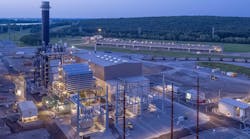The energy industry needs to evolve if it is to meet the twin challenges of rising energy demand and reducing emissions.
While renewable energies are developing rapidly, it is likely to take decades to transform the world’s energy systems from conventional to renewable power generation. To balance the priorities of energy security and lower emissions, the global power-generating industry needs to embrace--and invest more--in technological innovation.
The path we need to take is one paved with greater efficiencies and increasing reliability and safety.
To achieve these goals, we need to work together more collaboratively within the energy sector, drawing on the ancient Japanese concept of “chowa”—working in harmony with others—to jointly put our weight behind a mix of new technologies.
Making innovation mobile
Natural gas may become the world’s fastest-growing fossil fuel by 2040, and could reduce carbon emissions by up to 70% per unit of electricity compared to coal,
Natural gas only used to be available via inflexible and complex networks of pipes in which the gas was highly pressurized. However, technological innovation has led to the development of liquified natural gas (LNG), which is cooled down to extremely low temperatures and liquified so that it can now be transported wherever it is needed.
For example, “floating LNG power: combines LNG regasification, storage and electrical power generation on a single floating platform that will support efficient and effective LNG consumption.
LNG vessels can become part of “virtual pipelines.” These supply LNG to towns where mobile storage facilities can be connected to conventional distribution networks.
Trucks or trains can also supply virtual pipelines, and such transmission systems are already being used in isolated communities in Australia, New England, Alaska and remote parts of Canada.
It’s time to prioritize carbon capture and utilization
Carbon sequestration must be a priority in dealing with CO2 emissions from coal-fueled power generation, which is likely to dominate the sector until at least the middle of this century.
There has previously been little incentive to develop technologies to remove, store and even reuse carbon emissions.
But changes earlier this year to U.S. tax credits now offer more financial credits per ton of captured CO2 than were previously available. They also remove limits to how much can be stored at facilities like Petra Nova, the world's largest carbon capture, utilization and storage facility in the power sector.
And while the move could encourage more U.S. companies to develop and install sequestration technology, the effects could be felt far beyond North America’s shores.
For example, in countries such as South Africa, China and Indonesia, new cost-effective carbon capture technologies could help reduce emissions from older coal and gas-fired plants.
Great strides are being made towards the production of synthetic fuels, such as methanol, which can be synthesized from captured CO2. Research shows that methanol can be used to generate electricity cost effectively while reducing carbon emissions.
Hearing the ‘voice of the plant’
Digital Internet of Things (IoT) solutions are using artificial intelligence (AI) and machine-learning analytics to mine “big data” sets produced by turbines and other plant equipment in order to listen to "the voice of the power-producing plant."
In 2017, Mitsubishi Heavy Industries Group broke ground on the world’s first 570MW power plant that will be able to autonomously communicate, predict and analyze what is happening within it, and use this information to control itself.
AI is also taking on tasks such as monitoring and tuning gas turbines. Thousands of power-generating turbines around the world are already remotely monitored, with IoT technologies predicting and preventing problems. This use of accumulated data can reduce operational costs and lower emissions.
For example, a similar plant in Oklahoma has set a global 60 hertz combined-cycle efficiency record of 62%. It also reduced CO2 emissions by 65% compared to the coal-fired power plant it replaced.
Robots make for a safer work environment
While renewable energy sources are growing in importance, the exploration and production of fossil fuels, in particular natural gas, will continue to be a major component of the global energy industry. The highest priorities in the front line of oil and gas development are human safety and asset integrity. As an industry, our ambition must be to create a safe working environment for front-line workers while improving capital efficiencies.
With this aim in view, explosion-proof, remote-operated robots are being developed for oil and gas production facility inspections using the latest AI/IoT technologies.
Robots, which have already been deployed to inspect hazardous areas in industrial buildings and power plants, are equipped with cameras and tank-like crawlers that even allow them to climb stairs.
These can operate autonomously, freeing up working time and keeping human workers out of danger.
Robots have also been developed for other dangerous tasks, including one to tackle incidents few human firefighters would be able to deal with, such as petrochemical plant blazes.
But it is important to note that the future we envisage is not one in which human engineers are replaced by machines. Instead, specialist workers will have more information that will help guide decision-making.
Reaching our destination together
We have already embarked on the road to creating a secure and cleaner energy industry, but we will need to pass certain milestones to reach our ultimate destination.
In addition to the increased use of renewable energy sources, this will involve us continuing to innovate to make traditional power sources even cleaner and more sustainable.
But the commitment required to develop and deploy the technologies we need cannot be met by “lone fighters.”
Only by using the combined strength and scale of multiple organizations and investing in a range of developing technologies can the energy industry overcome some of its biggest challenges.
Shunichi Miyanaga is president and CEO, Mitsubishi Heavy Industries.




